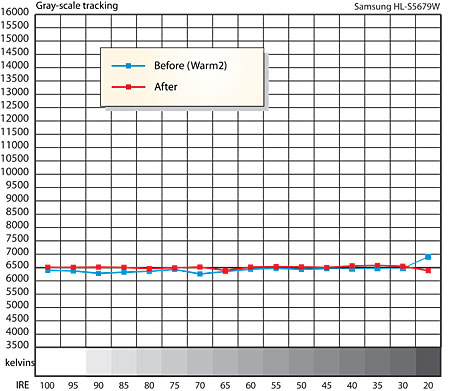Samsung HL-S5679W DLP Rear Projection Television Tests and Calibration
The Samsung's deinterlacing and scaling ranged from good to excellent in the Movie mode, even with 2:2 pulldown, video-based sources.
The noise reduction control had little effect on noisy source material, but the set itself produced negligible video noise.
At 480i and 480p, with either a component or HDMI input, both the luminance (black and white) and chroma (color) responses were crisply reproduced up to the maximum multiburst frequencies of my Accupel HDG-3000 test pattern generator (6.75MHz at 480i, 13.5MHz at 480p).
At 720p in both component and HDMI, the burst was resolved up to the pattern's maximum of 37.1MHz, though with some rolloff at this frequency, plus a bit of visible noise in the 37.1MHz burst in component. But at 1080i neither HDMI nor component had usable response at this frequency.
The Sharpness control could be set to 30 at any resolution, component or HDMI, without generating visible edge enhancement. And only the slightest trace of EE was visible at Sharpness settings as high as 50. This is one set in which the neutral setting of the Sharpness control appears to be at the midpoint (50).
But I did notice one bizarre issue involving 480i and 480p over both component and HDMI. If you set the sharpness control for optimum results at 480p, then switch to 480i and then back to 480p again, severe edge enhancement appears, even though the 480p Sharpness control setting is not changed. But if you then alter the Sharpness setting by as little as one step, the EE disappears! Very odd. This did not occur with either 720p or 1080i inputs.
At any resolution with either HDMI or component, the set's overscan averaged about 2.5% at the left, right, and top, but a somewhat high 4% at the bottom.
As noted in the review, the color points, both primary and secondary, were extremely accurate after calibration—probably the most accurate we have ever measured, with only the magenta off a bit (but still more accurate than we usually see). Even Magenta could likely be brought into line with further tweaking, but I suspect the difference would not be visible.
But the calibration procedure required to reach this result with this set is tedious, non-standard, and not particularly intuitive. Most calibration technicians are unlikely to have experience in this procedure either, which is very different from the steps required in the typical calibration. Techs may need to seek help from Samsung's service department. All recent Samsung sets offer a similar setup procedure, though lamp-based models may not provide the stunningly accurate results we obtained here. It should be noted that even prior to calibration, the primary color points in our sample were reasonably close to the standard, but the secondaries were off significantly (though no more than we often see).

The Samsung's color temperature, pre-calibration, ranged from a low of approximately 6300K in Warm2 to over 12,500K in Cool2. "Normal" measured above 9300K. After calibration, in Warm2, the result was very close to the D6500 standard, and was within 0.002 of the correct x/y coordinates from 20IRE to 100IRE—one of the best results we have ever recorded.
The Samsung's light output is lower than you'll find in many lamp-based sets. But I actually found the measured output of 105.4 (full field 100IRE white) more than ample (most single-chip front projectors are doing well if they produce 15fL). But its measured black level of 0.087 was one of the highest we have logged for a modern rear projection set. With the set configured for the best, most watchable picture it could produce, not the most impressive numbers, this resulted in a peak contrast ratio of 1212:1. This is far lower than the best currently available in a rear projection set.
- Log in or register to post comments
























































